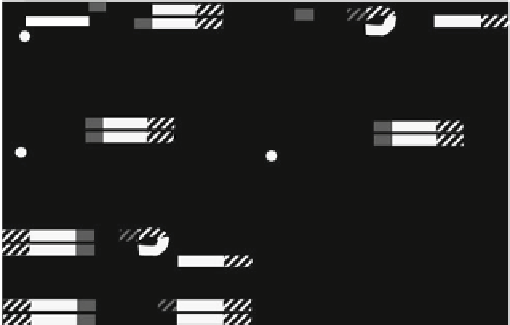Biomedical Engineering Reference
In-Depth Information
a
c
p
p
?
F
p
q
¬
A
Q
b
p
?
p
F
F
+
Q
E
Q
d
¬
p
q
p
?
A
E
q?
Fig. 7.6
Logic DNA computation: (
a
) representation of a proposition(
left
) and query (
right
)
molecules, (
b
) implementation of query reduction with a proposition, (
c
) representation of the
implication molecule (
left
) and auxiliary strand (
right
), and (
d
) implementation of query reduction
with an implication
7.4
Biomolecular Logical Deductions
Besides being able to implement complex Boolean logical circuits consisting of
sequences of logic gates, biomolecules, and in particular DNA can be used to per-
form simple logical deductions (
Ran et al. 2009
). Thus, biomolecular-implemented
simple programming languages can be developed in this way. In order to do this, the
propositions p (“Plato is a man”) are encoded in the 4-nt sticky end of a dsDNA,
one strand being the sense strand and ending with a fluorescent molecule F , while
the other, antisense strand ends with a matching quencher Q, which inhibits F .
Queries, denoted by p? (“Is Plato a man?”), are represented by a dsDNA with a
complimentary sticky end to that of p and a 5-nt recognition site for a restriction
enzyme E (the enzyme E cuts the two strands at different places at a certain distance
from its recognition site (dark color in Fig.
7.6
)).
Then, the query p? has a positive answer (“Yes”) by the proposition p;since
their sticky ends hybridize, the enzyme E is attracted to the recognition site on p?
and cuts the proposition molecule p. As a consequence, the sense and antisense
strands become separated, and the fluorescent molecule emits light if excited. The
light emission is interpreted as a positive response to the query. An implication,
denoted by p
q (“Plato is mortal if Plato is a man”), can be encoded in a hairpin
ssDNA, which consists of a 4-nt sticky end that represents p, a 4-nt section that
matches q, and a third, 5-nt section that matches an auxiliary complementary strand
A, both representing the recognition site for E. Then, p
q reduces the query
p? to the query q? (“Plato is mortal”), which implies that the positive answer to p?
guarantees a positive answer to q?. In solution, the sticky end of p? hybridizes with






















































Search WWH ::

Custom Search